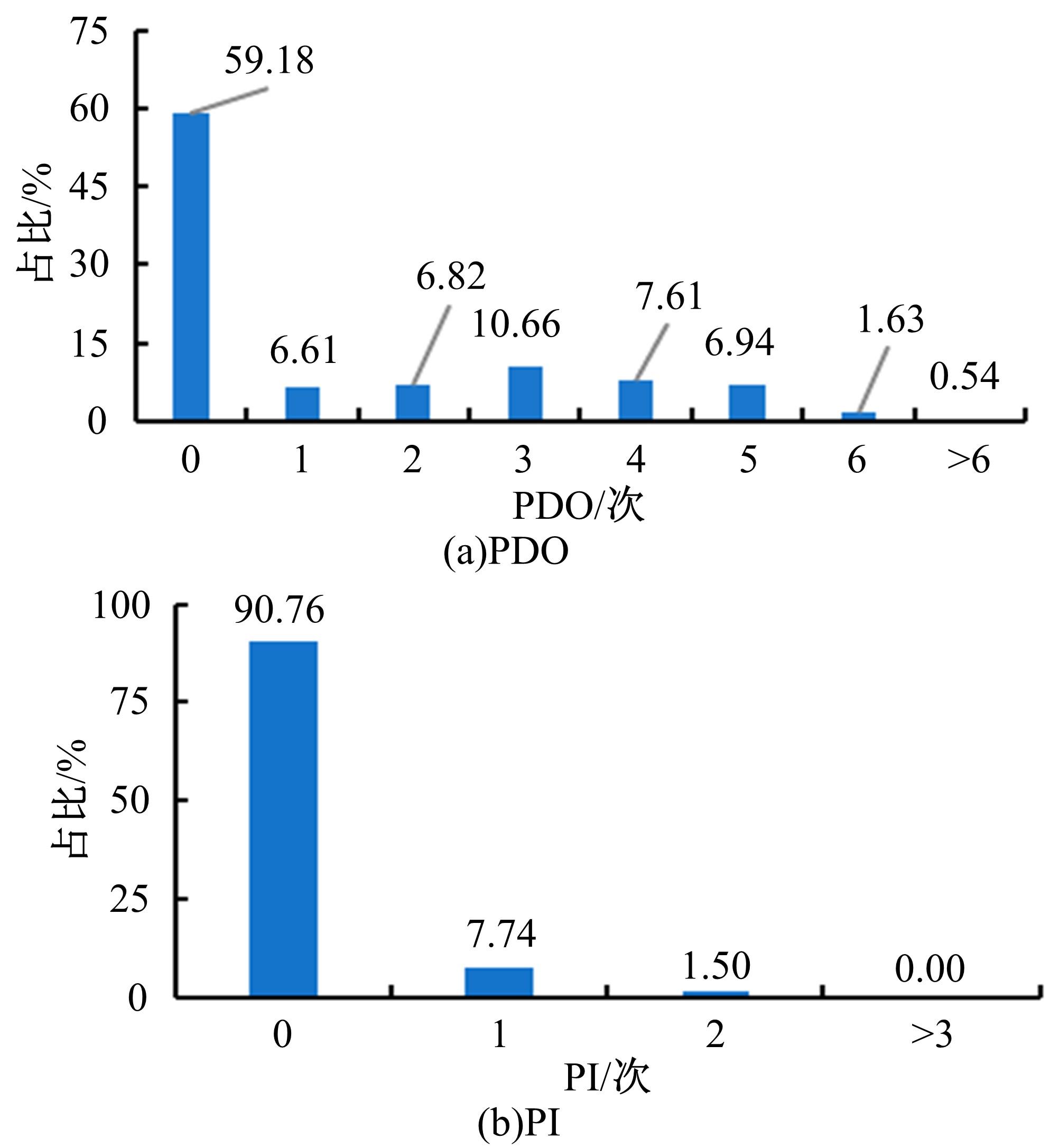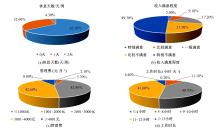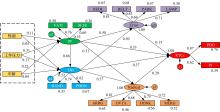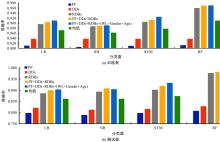Journal of Jilin University(Engineering and Technology Edition) ›› 2023, Vol. 53 ›› Issue (2): 457-467.doi: 10.13229/j.cnki.jdxbgxb20210614
Previous Articles Next Articles
Inducement analysis of taxi drivers' traffic accidents based on MIMIC and machine learning
Heng-yan PAN1( ),Wen-hui ZHANG2,Ting-ting LIANG3,Zhi-peng PENG1,Wei GAO4,Yong-gang WANG1(
),Wen-hui ZHANG2,Ting-ting LIANG3,Zhi-peng PENG1,Wei GAO4,Yong-gang WANG1( )
)
- 1.College of Transportation Engineering,Chang'an University,Xi'an 710064,China
2.School of Traffic and Transportation,Northeast Forestry University,Harbin 150040,China
3.School of Civil Engineering,Xi'an Traffic Engineering Institute,Xi'an 710399,China
4.School of Transportation Science and Engineering,Harbin Institute of Technology,Harbin 150090,China
CLC Number:
- U491
| 1 | Wang Y, Li L, Prato C G. The relation between working conditions, aberrant driving behaviour and crash propensity among taxi drivers in China[J]. Accident Analysis & Prevention, 2019, 126: 17-24. |
| 2 | Peng Z, Zhang H, Wang Y. Work-related factors, fatigue, risky behaviours and traffic accidents among taxi drivers: a comparative analysis among age groups[J]. International Journal of Injury Control and Safety Promotion, 2021, 28(1): 58-67. |
| 3 | Wang Y, Li M, Du J, et al. Prevention of taxi accidents in xi'an, China: what matters most?[J]. Central European Journal of Public Health, 2015, 23(1): 77-83. |
| 4 | Routley V, Ozanne S J, Qin Y,et al.Taxi driver seat belt wearing in nanjing,China[J].Journal of Safety Research, 2009, 40(6): 449-454. |
| 5 | Ma M, Yan X, Huang H,et al.Safety of public transportation occupational drivers: risk perception, attitudes, and driving behavior[J]. Transportation Research Record, 2010(1): 72-79. |
| 6 | Shi J, Li T, Li X, et al. A survey of taxi drivers' aberrant driving behavior in Beijing[J]. Journal of Transportation Safety & Security, 2014, 6(1): 34-43. |
| 7 | Meng F, Wong S C, Yan W,et al.Temporal patterns of driving fatigue and driving performance among male taxi drivers in hong kong: a driving simulator approach[J]. Accident Analysis & Prevention, 2019, 125: 7-13. |
| 8 | Lee S, Kim J, Park J, et al. Deep-learning-based prediction of high-risk taxi drivers using wellness data[J]. International Journal of Environmental Research and Public Health, 2020, 17(24): 17249505. |
| 9 | Peng Z, Wang Y, Luo X. How does financial burden influence the crash rate among taxi drivers? a self-reported questionnaire study in China[J]. Traffic Injury Prevention, 2020, 21(5): 324-329. |
| 10 | Sani S R H, Tabibi Z, Fassrdi J S, et al. Aggression, emotional self-regulation, attentional bias, and cognitive inhibition predict risky driving behavior[J]. Accident Analysis & Prevention, 2017, 109: 78-88. |
| 11 | Kim D, Sul J. Analysis of pedestrian accidents based on the in-vehicle real accident videos[C]∥Proceedings of 23rd International Technical Conference on the Enhanced Safety of Vehicles, Seoul, Korea, 2013: 1-12. |
| 12 | Akerstedt T, Anund A, Axelsson J,et al.Subjective sleepiness is a sensitive indicator of insufficient sleep and impaired waking function[J]. Journal of Sleep Research, 2014, 23(3): 240-252. |
| 13 | Boksem M A, Meijman T F, Lorist M M. Effects of mental fatigue on attention: an ERP study[J]. Cognitive Brain Research, 2005, 25(1): 107-116. |
| 14 | Ting P H, Hwang J R, Doong J L, et al. Driver fatigue and highway driving: a simulator study[J]. Physiology & Behavior, 2008, 94(3): 448-453. |
| 15 | Sullman M J, Stephens A N, Kuzu D. The expression of anger amongst Turkish taxi drivers[J]. Accident Analysis & Prevention, 2013, 56: 42-50. |
| 16 | Brandenburg S, Oehl M, Seigies K.German taxi drivers' experiences and expressions of driving anger: are the driving anger scale and the driving anger expression inventory valid measures?[J]. Traffic Injury Prevention, 2017, 18(8): 807-812. |
| 17 | 程国柱,冯思鹤,史伯睿.机动车非职业驾驶人事故倾向性测评方法[J].哈尔滨工业大学学报,2021,53(9): 99-106. |
| Cheng Guo-zhu, Feng Si-he, Shi Bo-rui.Evaluation method for accident proneness of non-professional motor vehicle drivers[J]. Journal of Harbin Institute of Technology, 2021, 53(9): 99-106. | |
| 18 | Asefa N G, Ingale L, Shumey A,et al.Prevalence and factors associated with road traffic crash among taxi drivers in Mekelle Town, Northern Ethiopia, 2014: a cross sectional study[J]. Plos One, 2015, 10(3): 118675. |
| 19 | Mokarami M, Alizadeh S S, Pordanjani T R, et al. The relationship between organizational safety culture and unsafe behaviors, and accidents among public transport bus drivers using structural equation modeling[J]. Transportation Research Part F: Traffic Psychology and Behaviour, 2019, 65: 46-55. |
| 20 | Cheng A S K, Ting K H, Liu K P, et al. Impulsivity and risky decision making among taxi drivers in Hong kong: an event-related potential study[J]. Accident Analysis & Prevention, 2015, 95: 387-394. |
| 21 | Burns P, Wilde J S. Risk taking in male taxi drivers: relationships among personality, observational data and driver records[J]. Personality and Individual Differences, 1995, 18(2): 267-278. |
| 22 | 江欣国,周悦,夏亮,等.出租车驾驶员交通违法行为演化博弈模型[J].西南交通大学学报, 2019, 54(6): 1121-1128, 1118. |
| Jiang Xin-guo, Zhou Yue, Xia Liang,et al.Evolutionary game model of traffic violations among taxi drivers[J]. Journal of Southwest Jiaotong University, 2019, 54(6): 1121-1128, 1118. | |
| 23 | 万平,吴超仲,马晓凤.基于ROC曲线和驾驶行为特征的驾驶愤怒强度判别阈值[J].吉林大学学报:工学版, 2020, 50(1): 121-131. |
| Wan Ping, Wu Chao-zhong, Ma Xiao-feng.Discriminating threshold of driving anger intensity based on driving behavior features by ROC curve analysis[J]. Journal of Jilin University(Engineering and Technology Edition), 2020, 50(1): 121-131. |
| [1] | Liang DUAN,Chun-yuan SONG,Chao LIU,Wei WEI,Cheng-ji LYU. State recognition in bearing temperature of high-speed train based on machine learning algorithms [J]. Journal of Jilin University(Engineering and Technology Edition), 2022, 52(1): 53-62. |
| [2] | Guang-song LI,Wen-qing LI,Qing LI. Encrypted and compressed traffic classification based on random feature set [J]. Journal of Jilin University(Engineering and Technology Edition), 2021, 51(4): 1375-1386. |
| [3] | Xiao-long ZHU,Zhong XIE. Geospatial data extraction algorithm based on machine learning [J]. Journal of Jilin University(Engineering and Technology Edition), 2021, 51(3): 1011-1016. |
| [4] | Yang LI,Shuo LI,Li-wei JING. Estimate model based on Bayesian model and machine learning algorithms applicated in financial risk assessment [J]. Journal of Jilin University(Engineering and Technology Edition), 2020, 50(5): 1862-1869. |
| [5] | Wei FANG,Yi HUANG,Xin-qiang MA. Automatic defect detection for virtual network perceptual data based on machine learning [J]. Journal of Jilin University(Engineering and Technology Edition), 2020, 50(5): 1844-1849. |
| [6] | Zhou-zhou LIU,Wen-xiao YIN,Qian-yun ZHANG,Han PENG. Sensor cloud intrusion detection based on discrete optimization algorithm and machine learning [J]. Journal of Jilin University(Engineering and Technology Edition), 2020, 50(2): 692-702. |
| [7] | Lu WANG,Yu⁃wen LIU,Hong CHEN. Cross-wind environment vehicle driving feature at canyon bridge and tunnel connection segment [J]. Journal of Jilin University(Engineering and Technology Edition), 2019, 49(3): 736-748. |
| [8] | Chao⁃ying YIN,Chun⁃fu SHAO,Xiao⁃quan WANG. Influence of urban built environment on car commuting considering parking availability [J]. Journal of Jilin University(Engineering and Technology Edition), 2019, 49(3): 714-719. |
| [9] | TAN Li-dong, LIU Dan, LI Wen-jun. Design of bionic compound eye array for traffic accident scene panorama based on fly compound eye [J]. 吉林大学学报(工学版), 2017, 47(6): 1738-1744. |
| [10] | LI Xian-sheng, MENG Xiang-yu, ZHENG Xue-lian, CHENG Zhu-qing, REN Yuan-yuan. Dynamic characteristics of liquid sloshing in partially-filled tank [J]. 吉林大学学报(工学版), 2017, 47(3): 737-743. |
| [11] | ZHAO Dong, ZANG Xue-bai, ZHAO Hong-wei. Random forest prediction method based on optimization of fruit fly [J]. 吉林大学学报(工学版), 2017, 47(2): 609-614. |
| [12] | XU Jin, CHEN Wei, ZHOU Jia, LUO Xiao, SHAO Yi-ming. Correlation between steering and driver's workload [J]. 吉林大学学报(工学版), 2017, 47(2): 438-445. |
| [13] | GUO Ying-shi, FU Rui, ZHAO Kai, MA Yong, YUAN Wei. Evaluation and test of real-time identification models of driver's lane change intention [J]. 吉林大学学报(工学版), 2016, 46(6): 1836-1844. |
| [14] | MO Chou, CHEN Ji-qing, LAN Feng-chong. Inverse sub-structuring transfer path analysis method [J]. 吉林大学学报(工学版), 2015, 45(6): 1751-1756. |
| [15] | WANG Zhe, YANG Bai-ting, LIU Xin, LIU Qun, SONG Xian-min. Discriminant analysis of driving decisions based on fuzzy clustering [J]. 吉林大学学报(工学版), 2015, 45(5): 1414-1419. |
|









